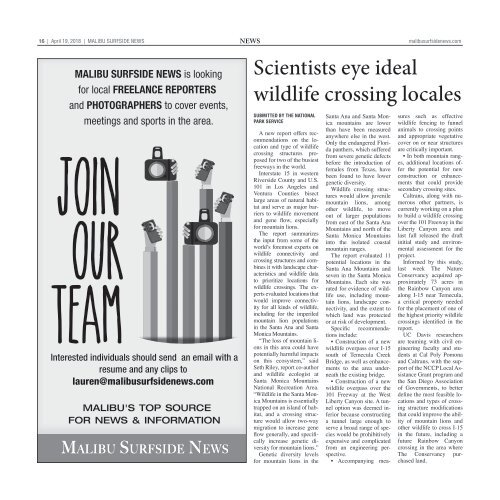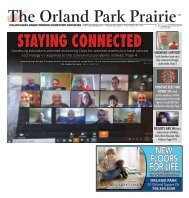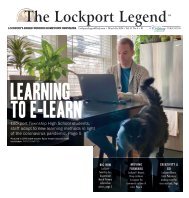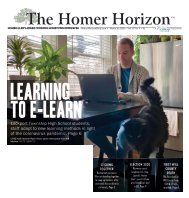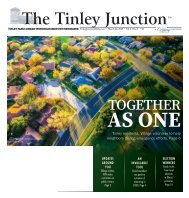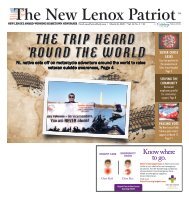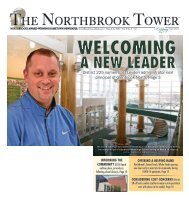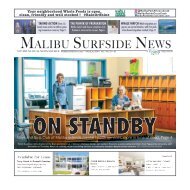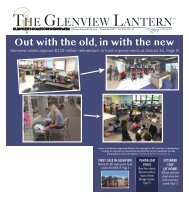MSN_041918
Malibu Surfside News 041918
Malibu Surfside News 041918
You also want an ePaper? Increase the reach of your titles
YUMPU automatically turns print PDFs into web optimized ePapers that Google loves.
16 | April 19, 2018 | Malibu surfside news News<br />
malibusurfsidenews.com<br />
MALIBU SURFSIDE NEWS is looking<br />
for local FREELANCE REPORTERS<br />
and PHOTOGRAPHERS to cover events,<br />
meetings and sports in the area.<br />
Interested individuals should send an email with a<br />
resume and any clips to<br />
lauren@malibusurfsidenews.com<br />
MALIBU'S TOP SOURCE<br />
FOR NEWS & INFORMATION<br />
MALIBU SURFSIDE NEWS<br />
Scientists eye ideal<br />
wildlife crossing locales<br />
Submitted by the National<br />
Park Service<br />
A new report offers recommendations<br />
on the location<br />
and type of wildlife<br />
crossing structures proposed<br />
for two of the busiest<br />
freeways in the world.<br />
Interstate 15 in western<br />
Riverside County and U.S.<br />
101 in Los Angeles and<br />
Ventura Counties bisect<br />
large areas of natural habitat<br />
and serve as major barriers<br />
to wildlife movement<br />
and gene flow, especially<br />
for mountain lions.<br />
The report summarizes<br />
the input from some of the<br />
world’s foremost experts on<br />
wildlife connectivity and<br />
crossing structures and combines<br />
it with landscape characteristics<br />
and wildlife data<br />
to prioritize locations for<br />
wildlife crossings. The experts<br />
evaluated locations that<br />
would improve connectivity<br />
for all kinds of wildlife,<br />
including for the imperiled<br />
mountain lion populations<br />
in the Santa Ana and Santa<br />
Monica Mountains.<br />
“The loss of mountain lions<br />
in this area could have<br />
potentially harmful impacts<br />
on this ecosystem,” said<br />
Seth Riley, report co-author<br />
and wildlife ecologist at<br />
Santa Monica Mountains<br />
National Recreation Area.<br />
“Wildlife in the Santa Monica<br />
Mountains is essentially<br />
trapped on an island of habitat,<br />
and a crossing structure<br />
would allow two-way<br />
migration to increase gene<br />
flow generally, and specifically<br />
increase genetic diversity<br />
for mountain lions.”<br />
Genetic diversity levels<br />
for mountain lions in the<br />
Santa Ana and Santa Monica<br />
mountains are lower<br />
than have been measured<br />
anywhere else in the west.<br />
Only the endangered Florida<br />
panthers, which suffered<br />
from severe genetic defects<br />
before the introduction of<br />
females from Texas, have<br />
been found to have lower<br />
genetic diversity.<br />
Wildlife crossing structures<br />
would allow juvenile<br />
mountain lions, among<br />
other wildlife, to move<br />
out of larger populations<br />
from east of the Santa Ana<br />
Mountains and north of the<br />
Santa Monica Mountains<br />
into the isolated coastal<br />
mountain ranges.<br />
The report evaluated 11<br />
potential locations in the<br />
Santa Ana Mountains and<br />
seven in the Santa Monica<br />
Mountains. Each site was<br />
rated for evidence of wildlife<br />
use, including mountain<br />
lions, landscape connectivity,<br />
and the extent to<br />
which land was protected<br />
or at risk of development.<br />
Specific recommendations<br />
include:<br />
• Construction of a new<br />
wildlife overpass over I-15<br />
south of Temecula Creek<br />
Bridge, as well as enhancements<br />
to the area underneath<br />
the existing bridge.<br />
• Construction of a new<br />
wildlife overpass over the<br />
101 Freeway at the West<br />
Liberty Canyon site. A tunnel<br />
option was deemed inferior<br />
because constructing<br />
a tunnel large enough to<br />
serve a broad range of species<br />
would be prohibitively<br />
expensive and complicated<br />
from an engineering perspective.<br />
• Accompanying measures<br />
such as effective<br />
wildlife fencing to funnel<br />
animals to crossing points<br />
and appropriate vegetative<br />
cover on or near structures<br />
are critically important.<br />
• In both mountain ranges,<br />
additional locations offer<br />
the potential for new<br />
construction or enhancements<br />
that could provide<br />
secondary crossing sites.<br />
Caltrans, along with numerous<br />
other partners, is<br />
currently working on a plan<br />
to build a wildlife crossing<br />
over the 101 Freeway in the<br />
Liberty Canyon area and<br />
last fall released the draft<br />
initial study and environmental<br />
assessment for the<br />
project.<br />
Informed by this study,<br />
last week The Nature<br />
Conservancy acquired approximately<br />
73 acres in<br />
the Rainbow Canyon area<br />
along I-15 near Temecula,<br />
a critical property needed<br />
for the placement of one of<br />
the highest priority wildlife<br />
crossings identified in the<br />
report.<br />
UC Davis researchers<br />
are teaming with civil engineering<br />
faculty and students<br />
at Cal Poly Pomona<br />
and Caltrans, with the support<br />
of the NCCP Local Assistance<br />
Grant program and<br />
the San Diego Association<br />
of Governments, to better<br />
define the most feasible locations<br />
and types of crossing<br />
structure modifications<br />
that could improve the ability<br />
of mountain lions and<br />
other wildlife to cross I-15<br />
in the future, including a<br />
future Rainbow Canyon<br />
crossing in the area where<br />
The Conservancy purchased<br />
land.


